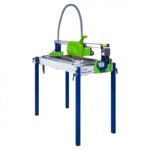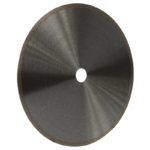For anyone who will be cutting brick, stone, concrete, etc.. Using a masonry saw for the first time, you should know that the process isn’t very complicated. In fact, well-made machines are designed to be quite user friendly. That being said, there are a few essential tips you should have handy in order to make sure that everything goes smoothly the first time you try out a masonry cutting saw.
Contents
In this article, we’ve put together five basic but very important tips to keep in mind before, during and even after cutting.
5 important tips for new masonry cutting saw users
1. Use the right masonry cutting saw blade
All masonry saws require a diamond blade in order to cut through brick, stone, concrete, and other similar materials. However, not all diamond blades are the same! In addition to making sure the blade is the correct size for your masonry cutting saw, you should also try to choose a blade that is specifically indicated for whatever you are cutting. On the microscopic level, marble is very different from, say, porcelain.
Also, note that most masonry blades are designed for wet cutting. You can use a dry cutting blade for wet cutting, but not the other way around. This is very important! See tip #4 for details.
2. It’s called ‘wet cutting’ for a reason
Masonry saws come with either a built-in water tank and pump, or an attachment for your garden hose. Wet cutting is preferable over dry in almost all situations, because of safety and practicality. This means it’s important to check the water level before you start using the masonry cutting saw, and test the pump to make sure water will flow freely over the blade once you start to cut.
3. Slow and steady wins the race
Some people are tempted to push their bricks into the blade with a lot of pressure to try to make it cut faster. Resist this temptation. It’s bad for the blade, can result in chipping with certain materials, and can even cause a safety hazard. Let the masonry saw determine the cutting speed, and just guide the brick gently into the blade.
4. If you absolutely must do a dry cut…
Dry cutting should be avoided if at all possible. But if you need to do it in some extenuating circumstance, you need to do things a bit differently. Firstly, it is mandatory to use a diamond blade specifically labeled for dry cutting. Secondly, it is also mandatory to wear a good respirator mask; in addition to standard protective gear like safety glasses. Third, you won’t be able to cut for more than a few seconds at a time without the blade overheating, so work in short, shallow passes with cooling time in between.
5. Sharpen the masonry cutting saw blade like this
If you are using the right blade for your material and wet cutting, you shouldn’t need to sharpen your blade. But sometimes it does happen that the metal holding the diamonds onto the blade softens and deforms, covering up the diamonds and keeping them from doing their job. In this case, you can use the masonry cutting saw to cut through a dressing wheel, an old grinding wheel, or something made from silicon carbide, just as you normally would cut. This should abrade the metal, exposing the diamonds so you can continue cutting.




